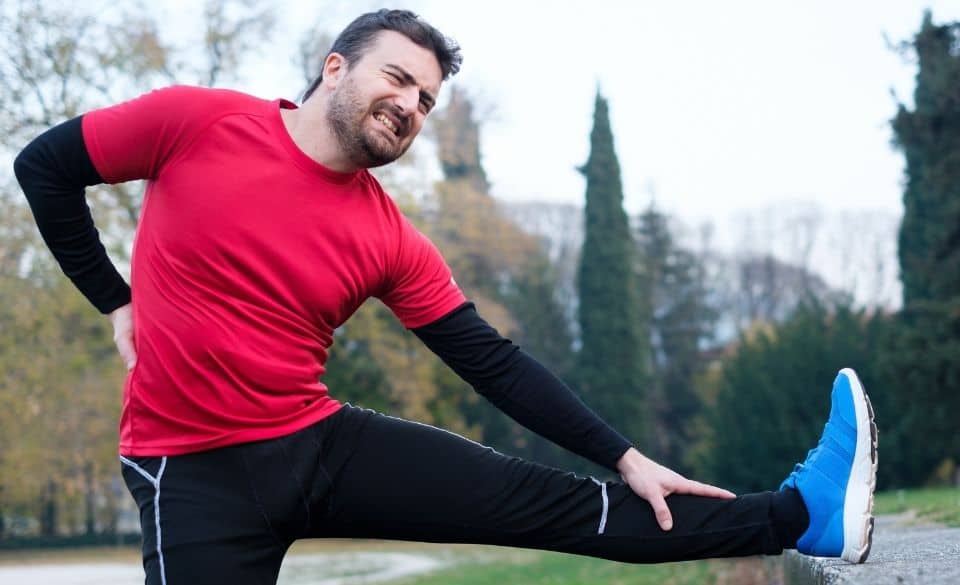
Lower Back Pain From Running – How to Prevent it? UPDATED 2021
Page Contents
Runners are often used to dealing with constant niggles. However, one niggle that often gets overlooked is lower back pain from running.
Back pain is a frequent symptom that we accept as part of our life. Things like sitting at a desk all day, age, or heavy lifting are all things we need to deal with on a daily basis.
For most people though back pain from running typically comes from a specific cause. Which means it can be remedied, treated, and prevented without too much problem.
This article outlines what causes lower back pain when running and what you can do to treat and prevent it from happening again.
What Causes Lower Back Pain When Running?
If you are thinking sitting at a desk causes lower back pain when running, you aren’t far from the truth. 70% of runners that experience lower back pain when running work at a desk for more than 8 hours a day. This often results in poor posture especially when they are standing in an upright position.
However, don’t expect lower back pain if you don’t work at a desk. There are more than 150 different structures that can cause issues in the lower back. One of these structures is the Sciatic nerve in the hip.
Many runners experience adhesion between the sciatic nerve and piriformis muscle. This leads to pain and inflammation in and around the back, both during and after running.
This is often caused by overuse and lack of stretching or mobility work.
If you aren’t experiencing adhesion between the sciatic nerve and piriformis muscle, it may be a running gait issue.
Runners that tend to overstride, heel strike, and stomp when they run are more likely to experience lower back pain. People that consistently experience pain or discomfort in their back when running should look at getting a 2D or 3D running gait analysis. Doing so can help to see if your running technique needs to be modified. Alternatively, it may help you find areas of weakness that need to be strengthened.
Another common cause of back pain when running is a weak core. When you are increasing mileage or intensity, poor core strength can often lead to a breakdown in trunk stability. This is especially common with runners than increase the volume too quickly.
That means the lumbar spine and pelvis take more of the load when running, this often results in aches and pain throughout the lower back. Most runners find this happening near the end of their long runs.
So, generally, a lack of strength in the core and surrounding lower back muscles are a large cause of most runners’ back pain. Paired with the runner doing too much too soon can end up overloading the back muscles.

What Causes Lower Back Pain After Running?
There are times where you have finished your run and a few hours later you start to experience an achy back. So, what causes lower back pain after running, and is this the same as during?
Back pain during and after running has similar causes. However, there may be some other issues causing back pain after running.
Dehydration – Dehydration can cause muscle spasms after a run. So it is not uncommon if you finished your run in a dehydrated state that you experience muscles spasms in the back.
Overuse – If you have recently started to increase your mileage too quickly, you might be struggling to give the body enough time to recover. Make sure that you allow adequate recovery to allow the core and lower back to strengthen as you increase the duration of your runs.
Tight Hamstrings – Tight hamstrings are a common cause of back issues for the runner. Since the hamstrings and glutes are connected to the back they can play a part in any issues you may be experiencing. Remember to stretch and foam roll, as well as perform any mobility exercises during the week to help keep your hamstrings supple.
Poor Equipment – Last but not least is running shoes. Worn-out running shoes can affect your running gait which can lead to pain in the back. It can also cause jarring in the bones when you run. So keep track of the mileage you are running in your shoes and replace them when needed.

Is it OK to Run With Back Pain?
Generally, if your posture is not affected and the pain is not severe it is ok to run with back pain. However, if the pain increases as you run, it is important to stop and rest.
It is also important to keep track of where the pain is located and if it moves throughout your run or after you run.
While it is important to rest if you experience pain in general, sometimes some light running can help loosen up the surrounding muscles. However, if the pain is too severe to run, try getting a deep tissue massage or do some foam rolling. Both will help to relieve any tense muscles in the lower and upper regions of the back.
How Do You Get Rid of Back Pain When Running?
For most people that experience back pain, there are a few small things you can do to help get rid of back pain when running. A few of these include:
– Slowly your pace down.
– Adjust your running posture slightly.
– Varying the terrain you run on.
– Run offroad or on a softer surface.
– Stop and stretch every 15 minutes.
For most people continuing to run won’t get rid of the back pain. However, some of the things above can help reduce any discomfort you may experience.
Remember if the pain gets worse when running, you are better to stop and let it recover. Then spend some time foam rolling and stretching the back muscles, then look at what’s causing the problem. Whether it be your running posture, sitting at a desk all day, or a more serious underlying condition.



